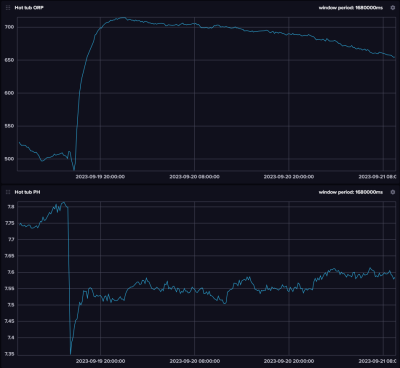Like swimming pools, hot tubs need regular monitoring to ensure their water stays clean and clear. An average person might take a water quality reading once or twice a week using test strips, but such a low sampling rate obviously won’t do for a hacker. [Stephen Carey] has therefore built a hot tub monitor that checks the water quality every minute and reports it on a neat mobile dashboard.
[Stephen]’s system uses commercially available sensors that track pH levels and Oxidation-Reduction Potential (ORP), both basic measurements that indicate water quality. A second set of sensors keeps track of the temperature of the water and the outside air, which should help in finding insulation failures and keeping energy use under control.
 An ESP32 reads the sensors and sends out the data through WiFi. [Stephen] programmed the ESP32 in MicroPython, using an MQTT driver to connect it to Home Assistant. By looking at the graphs generated, you can tell when someone entered the tub from a step change in pH and ORP. It’s even possible to generate alerts when any of the values drift outside their acceptable range – we can already imagine an alarm going off when someone enters without having showered first.
An ESP32 reads the sensors and sends out the data through WiFi. [Stephen] programmed the ESP32 in MicroPython, using an MQTT driver to connect it to Home Assistant. By looking at the graphs generated, you can tell when someone entered the tub from a step change in pH and ORP. It’s even possible to generate alerts when any of the values drift outside their acceptable range – we can already imagine an alarm going off when someone enters without having showered first.
The system also has a calibration mode to check the sensors against a well-defined buffer solution. As with many chemical sensors, the pH and ORP probes gradually lose their active material and need to be replaced after about a year. Good ones aren’t cheap, but [Stephen] has found pretty decent low-cost alternatives on AliExpress that should be fine for a home setup.
If you also want your tub or pool to be actively managed, you’ll need a more complex system, perhaps even one that can also dispense chemicals. If your hot tub is heated by a wood fire, however, all you need is a way to alert the person tending the fire.

















The combination of Home Assistant+ ESPHome + ESP32 SOCs provides powerful nearly unlimited automation and monitoring capability that is inexpensive and relatively easy to implement
Thanks, I will have to check it out.
“… An average person might take a water quality reading once or twice a week using test strips …”
A hot tub with used water that has been sitting around for a week or more is surely interesting for microbiologists. Do people actually bathe in such a disgusting brew?
Do you think they dump out your local swimming pool at the end of the week? It’s perfectly safe with properly maintained chemistry and filtration.
A public swimming pool isn’t heated to body temperature, has a highly effective cleaning system and gets continuously filled up with fresh water. Thermal spas often replace the water more than once a week.
“continuously filled up”? Where is this water going that it needs filled continuously? In both a (freshwater, obviously) pool and a hot tub (jacuzzi, spa), the water’s kept clean and fresh by filtration, keeping the pH balanced properly to prevent growth, and the use of chlorine to kill all microbiologicals. The only reasons the water usually needs filled or replaced is evaporation (slow, but faster with hot tubs at 104° F/40 ° C) or contamination (or more rarely, chemical balance is so far from acceptable that some or all must be drained). In my experience, most pools and hot tubs have their water filled/replaced once or twice a year (usually coincides with cleaning/maintenance schedule).
You forgot about leaky pools.
It is cheaper to replace missing water than the cost of replacing the pool.
In France it’s mandatory to replace water in public swimming pool.
It’s given in the norm: 30l per day per allowable swimmer.
So if you public pool is meant to receive 100 swimmer per day, that’s 3m³ per day of water consumption.
Private pool can do whatever they please, the only rule is to use potable water.
After owning a few hot tubs, really geeking out and really understanding pool chemistry, I quickly learned that many public and private spas are disgusting and not maintained properly.
Cloudy water and a strong chlorine or biological smell are indicators of badly maintained water.
If you’re really on top of things and maintain a healthy level of chlorination and maintenance, the water should be crystal clear, and chlorine smell barely noticeable. The website trouble free pool is awesome for Hackaday minded individuals who own a pool or spa.
You could maybe go a whole year with properly maintained and filtered water in a lightly used residential setting. I’d drain and refill mine after any party with friends though.
A quick aside…. If you own a hot tub and want to drain it really fast:
Use a wet/dry vac with an extended 2” diameter hose. Use the vacuum to get a water siphon started, then pull the hose from the vacuum and let gravity do the rest.
As a bonus, you can then use the flowing hose to suck up debris from the bottom of the spa while it’s draining. You can drain a 500 gallon spa in just a couple minutes doing this!
I have made a similar project with ESP32 and hot tub sensors. Please check it out: https://github.com/mzakharo/tubby. In addition, my project runs on battery and uses Machine learning to provide PPM bromine instead of just raw ORP/pH values.